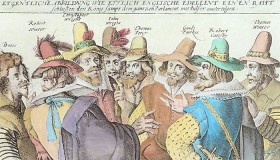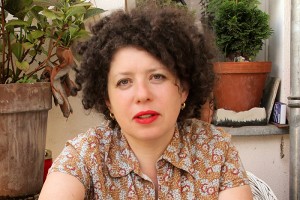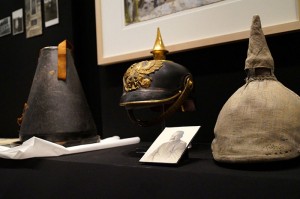The 9th of November was not a day of national commemoration in England, where I grew up. We had to
“Remember, remember the 5th of November, gunpowder, treason and plot…”

The Gunpowder Plot Conspirators, unknown engraver, ca. 1605-1606
This was the date on which Guy Fawkes, a Catholic renegade, dramatically failed to blow up London’s House of Lords. This cultural memory has been faithfully preserved for over 400 years. However, the 9th of November never went unremarked in our household. It was always referred to in German with a shudder: “Kristallnacht,” a name and concept for which no English equivalent exists.
Moving to Germany in 2001, I was surprised to discover that the 9th of November was indeed a day when the organized pogroms against Jews in Germany in 1938 were discussed in the media and commemorative events were held. → continue reading
With her works for our art vending machines, Deborah Wargon exposes things that got swept under the rug

Portrait of Deborah Wargon © Jewish Museum Berlin, photo: Gelia Eisert
A cordial welcome, the wafting flavors of a freshly-cooked meal, a light-drenched room with a high ceiling, full of brightly-colored books and pictures, and a piano with a sign-post ‘to Australia’ sitting on it… My first encounter with Deborah Wargon in her live-in atelier in Berlin’s Prenzlauer Berg neighborhood is a far cry from the rather severe, somber associations that the term ‘testament enforcer’ brings up for me. Wargon – a musician as well as visual and theater artist born in Melbourne in 1962 – describes herself this way on the package insert that comes with the small-scale artworks that she created for the art vending machine in our permanent exhibition. Those artworks bear the title “The Legacy of Friede Traurig” – where Friede Traurig doubles as a proper name and, in German, to mean peace sorrowful. And Deborah Wargon, who is best known for her paper cuttings inside former insect cases, says that she would rather be sorrowful.
With a little good luck, you may get one of her works from the vending machine: for instance, a little human figurine made of rail track ballast (gravel), wire, and newspaper. Aside from the expressive name Friede Traurig, the materials invoke woeful stories of train transports and barbed wire fences, particularly because the newspapers she used are from the Second World War. But for the artist, it’s clearly not only about the specific time the Nazis were in power and the Shoah. It’s also about the legacies, the inheritance, the stories that we all carry with us. She explains her choice of materials: “For me, wire is a fascinating material. It’s also used for cages. So you can use to suggest the ways that we’re all captive.” The rail track gravel, which normally lies on the ground, relates for Wargon to the ground that we all walk on, as descendants of the people who came before us. “Besides, in both German and English there’s the expression ‘to sweep something under the rug’”. The gravel, or grit, that we bring into the house on the soles of our shoes, and then sweep under the rug, stands for something that we don’t want to face and deal with.
→ continue reading
Or: How 300 Artifacts from our Collection Were Turned into a Cabinet Exhibition about the First World War

Objects from our collections in the exhibition “The First World War in Jewish Memory”
© Jewish Museum Berlin, photo: Mariette Franz
Our exhibition “The First World War in Jewish Memory” opened last week. It is based primarily on collections donated to the Jewish Museum by German-Jewish families and each exhibit tells a very personal story.
In total, 176 exhibits were selected, researched and arranged as a visual narrative by eight curators, six restorers, two exhibition technicians, a translator and a graphic artist. So, even before I mention our numerous willing helpers in the wings, in particular the student assistants and the Museum caretaker, this sounds like a big team for a big exhibition. In fact, our joint endeavor culminated in a small cabinet exhibition relating to the First World War, which can be viewed until 16 November in the Rafael Roth Learning Center. → continue reading


